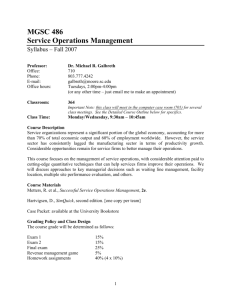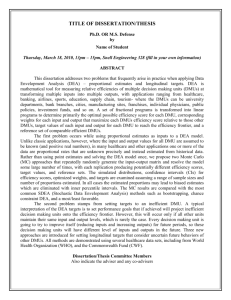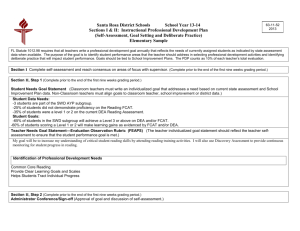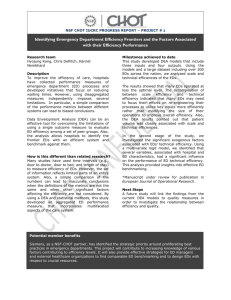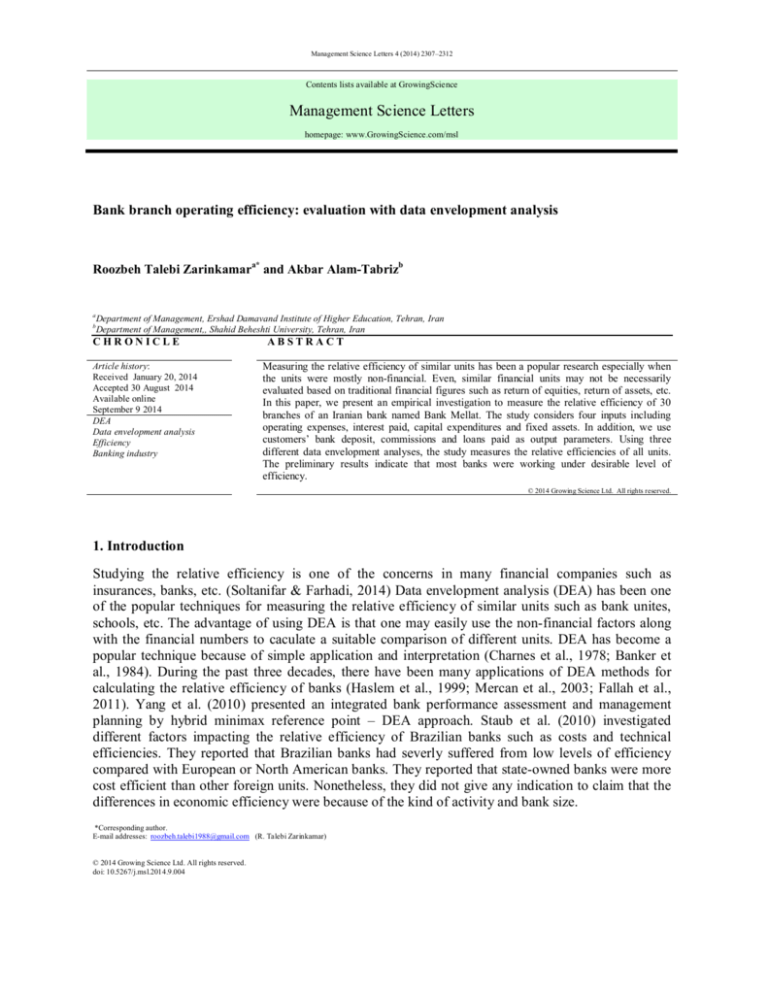
Management Science Letters 4 (2014) 2307–2312
Contents lists available at GrowingScience
Management Science Letters
homepage: www.GrowingScience.com/msl
Bank branch operating efficiency: evaluation with data envelopment analysis
Roozbeh Talebi Zarinkamara* and Akbar Alam-Tabrizb
a
b
Department of Management, Ershad Damavand Institute of Higher Education, Tehran, Iran
Department of Management,, Shahid Beheshti University, Tehran, Iran
CHRONICLE
Article history:
Received January 20, 2014
Accepted 30 August 2014
Available online
September 9 2014
DEA
Data envelopment analysis
Efficiency
Banking industry
ABSTRACT
Measuring the relative efficiency of similar units has been a popular research especially when
the units were mostly non-financial. Even, similar financial units may not be necessarily
evaluated based on traditional financial figures such as return of equities, return of assets, etc.
In this paper, we present an empirical investigation to measure the relative efficiency of 30
branches of an Iranian bank named Bank Mellat. The study considers four inputs including
operating expenses, interest paid, capital expenditures and fixed assets. In addition, we use
customers’ bank deposit, commissions and loans paid as output parameters. Using three
different data envelopment analyses, the study measures the relative efficiencies of all units.
The preliminary results indicate that most banks were working under desirable level of
efficiency.
© 2014 Growing Science Ltd. All rights reserved.
1. Introduction
Studying the relative efficiency is one of the concerns in many financial companies such as
insurances, banks, etc. (Soltanifar & Farhadi, 2014) Data envelopment analysis (DEA) has been one
of the popular techniques for measuring the relative efficiency of similar units such as bank unites,
schools, etc. The advantage of using DEA is that one may easily use the non-financial factors along
with the financial numbers to caculate a suitable comparison of different units. DEA has become a
popular technique because of simple application and interpretation (Charnes et al., 1978; Banker et
al., 1984). During the past three decades, there have been many applications of DEA methods for
calculating the relative efficiency of banks (Haslem et al., 1999; Mercan et al., 2003; Fallah et al.,
2011). Yang et al. (2010) presented an integrated bank performance assessment and management
planning by hybrid minimax reference point – DEA approach. Staub et al. (2010) investigated
different factors impacting the relative efficiency of Brazilian banks such as costs and technical
efficiencies. They reported that Brazilian banks had severly suffered from low levels of efficiency
compared with European or North American banks. They reported that state-owned banks were more
cost efficient than other foreign units. Nonetheless, they did not give any indication to claim that the
differences in economic efficiency were because of the kind of activity and bank size.
*Corresponding author.
E-mail addresses: roozbeh.talebi1988@gmail.com (R. Talebi Zarinkamar)
© 2014 Growing Science Ltd. All rights reserved.
doi: 10.5267/j.msl.2014.9.004
2308
Avkiran (2010) investigated the relationship between the supper-efficiency estimations and some
major key financial ratios for Chinese banking sector. The technique provided some opportunity to
determine the inefficient units where there was a low correlation between the supper-efficiency and
good financial ratios. Lin et al. (2009) applied various DEA models for 117 branches of a certain
bank in Taiwan and reported an overall technical efficiency of 54.8 percent for all banks. They also
explained that most branches had been relatively inefficient. Thoraneenitiyan and Avkiran (2009)
investigated DEA and stochastic frontier analsysis (SFA) to measure the impact of restructuring and
country-specific factors on the efficiency of post-crisis east Asian banking systems. They stated that
banking system inefficiencies were primarlity due to country-specific conditions, such as high interest
rates, concentrated markets and economic development. DEA was also implemented for banking
decisions. For example, Che et al. (2010) applied a combination of Fuzzy analytical hierarchy
procedure (AHP) and DEA as a decision making facility for making bank loan decisions.
2. The proposed study
The constant return to scale DEA (CCR) was initially proposed by Charnes, et al. (1978, 1994) as a
mathematical technique for measuring the relative efficiency of decision making units (DMU). One
can easily find out how a given DMU works whenever a production function is available.
s
max Z 0 ur yr 0
,
r 1
subject to
m
v x
i i0
1
r 1
s
m
u y
r
r0
r 1
(1)
vi xi 0 0
r 1
(r 1,, s ),(i 1,, m),( j 1,, n), ur , vi 0
where x and y represent the input and output vectors, respectively. In addition, u and v are dual
variables associated with input/outputs, respectively. The CCR production feasibility set border
determines the relative efficiency in which any off-border DMU is considered as inefficient. The
CCR model can be detected in two forms of either input or output oriented. The input CCR aims to
decrease the maximum input level and can be represented as follows,
s
max Z0 ur yr 0 W
r 1
subject to
m
v x
i i0
1
(2)
r 1
s
m
u y
r
r1
r 1
xijvi W 0
i 1
(r 1,, s ),(i 1,, m),( j 1,, n), ur , vi 0
The difference between Model (1) and Model (2) is associated with the free variable, W. When W>0
The resturn to scale is in the form in deceasing, when W=0 we have a constant return to scale model
and finally when W<0, the return is to scale in increasing form. Finally, Model (3) demonstrates the
maxmin model as follows,
max Z0 M
subject to
m
v x
i i0
1
(3)
r 1
s
m
u y x v d
r
r 1
rj
ij i
j
0
i 1
M dj 0
(r 1,, s ),(i 1,, m),( j 1,, n), ur , vi , d j 0
2309
R. Talebi Zarinkamar and A. Alam-Tabriz / Management Science Letters 4 (2014)
where M represents the deviation from the desirable value. One of the issues associated with DEA
model is that we may receive more than one efficient unit and to rank the efficient units, Anderson
Peterson model can be use.
3. Case study
In this paper, we use the proposed model explained in the previous section to measure the relative
efficiency of 30 Iranian banks named Bank Mellat located in city of Tehran, Iran. The proposed DEA
model of this paper considers 4 inputs including operating expenses, interest paid, capital
expenditures and fixed assets. In addition, we use customers’ bank deposit, commissions and loans
paid as output parameters. Table 1 demonstrates the results of measuring the relative efficiency of 30
units based on the implementation of model 1 and model 2.
Table 1
The summary of the results of CCR and BCC models introduced in Model (1) and Model (2)
Unit
1
2
3
4
5
6
7
8
9
10
11
12
13
14
15
CCR
0.7576
1
0.8603
1
1
1
1
0.7627
1
0.5277
0.5245
0.8196
0.4683
1
1
BCC
0.8801
1
1
1
1
1
1
1
1
1
0.8653
1
1
1
1
Unit
16
17
18
19
20
21
22
23
24
25
26
27
28
29
30
CCR
1
0.5137
1
0.7286
1
1
0.7917
0.969
1
1
0.6438
0.892
1
0.7681
1
BCC
1
0.6218
1
0.7301
1
1
1
1
1
1
0.6781
0.8934
1
0.7912
1
As we can observe from the results of Table 1, most units are represented as efficient ones and the
results somewhat confuses decision maker. Therefore, we use Model (3) to measure the efficiency of
various units. Table 3 summarizes the results of our survey.
Table 3
The summary of measuring the relative efficiency of 30 units based on minmax model
Unit
1
2
3
4
5
6
7
8
9
10
11
12
13
14
15
MinMax model
0.6738
0.3082
0.5184
0.68
0.9889
0.5144
0.5503
0.526
0.4055
0.3008
0.083
0.149
0.2225
0.6217
0.4783
Unit
16
17
18
19
20
21
22
23
24
25
26
27
28
29
30
MinMax model
0.973
0.2792
1
0.4779
0.4766
0.7707
0.2367
0.3953
0.809
0.7032
0.4747
0.6389
0.4618
0.3166
0.9874
According to the results of Table 3, only one unit, unit 18, is considered to be efficient and the other
units are stated as inefficient. The average efficiencies of model 1, 2 and 3 are 0.87, 0.95 and 0.53,
2310
respectively. In order to have a better insight on the relative efficiency of efficient as well as
inefficient units and comparing with the results of maxmin method we apply Anderson Peterson
method (Andersen & Petersen 1993) and Table 4 summarizes the results of our investigation.
Table 4
The summary of Anderson Peterson method for measuring super efficiency
Unit
1
2
3
4
5
6
7
8
9
10
11
12
13
14
15
16
17
18
19
20
21
22
23
24
25
26
27
28
29
30
CCR
0.7576
1
0.8603
1
1
1
1
0.7627
1
0.5277
0.5245
0.8196
0.4683
1
1
1
0.5137
1
0.7286
1
1
0.7917
0.969
1
1
0.6438
0.892
1
0.7681
1
Efficiency
BCC
0.8801
1
1
1
1
1
1
1
1
1
0.8653
1
1
1
1
1
0.6218
1
0.7301
1
1
1
1
1
1
0.6781
0.8934
1
0.7912
1
MinMax
0.6738
0.3082
0.5184
0.68
0.9889
0.5144
0.5503
0.526
0.4055
0.3008
0.083
0.149
0.2225
0.6217
0.4783
0.973
0.2792
1
0.4779
0.4766
0.7707
0.2367
0.3953
0.809
0.7032
0.4747
0.6389
0.4618
0.3166
0.9874
Anderson Peterson
CCR
BCC
1.01303
1.024
1.0091
1.25195
1.2519
2.09521
2.5041
2.58889
2.5888
1.40698
1.4069
1.0742
1.05127
1.0529
2.5293
1.5724
1.1036
1.05842
1.2887
1.1323
1.4061
1.4648
1.4648
5.5751
5.57513
1.33303
1.333
1.2292
1.2292
1.1377
1.06891
1.59994
1.5999
1.6411
1.641
1.57122
2.5712
2.35804
2.358
CCR
24
16
19
11
4
2
9
23
15
27
28
20
30
14
13
8
29
1
25
10
12
21
17
6
5
26
18
7
22
2
Rank
BCC
25
22
23
15
5
2
11
19
21
4
26
9
18
14
12
10
30
1
28
13
16
17
20
8
7
29
24
3
27
6
MinMax
9
24
14
8
2
15
12
13
21
25
30
29
28
11
16
4
26
1
17
18
6
27
22
5
7
19
10
20
23
3
As we can observe from the results of Table 4, Anderson Peterson method (Andersen & Petersen,
1993; Anderson et al., 2011) yields the same results as the maxmin method.
4. Discussion and Conclusion
In this paper, we have presented an empirical investigation to study the performance of selected
banks in city of Tehran, Iran. The proposed study has considered 4 inputs including operating
expenses, interest paid, capital expenditures and fixed assets. In addition, the study has used
customers’ bank deposit, commissions and loans paid as output parameters. Using different DEA
techniques, the study has measured the relative efficiency of various 30 branches. The results have
indicated that most banks were operating well above the average. In addition, the implementation of
minmax method has appeared to present better results in terms of super efficiency. The results of
implementation of DEA techniques have been repeatedly used in other applications. Ehsani and
Danaei (2014) applied a combination of DEA and Technique for Order of Preference by Similarity to
Ideal Solution (TOPSIS) for ranking banks. In their survey, they first used CCR method to rank all
different banks and then used TOPSIS technique to rank efficieny units. Shabani and Shams (2014)
measured the performance of accepted investment companies in Tehran’s stock exchange by value
efficiency analysis, which is an extension of data envelopment analysis. Rahimian and Soltanifar
R. Talebi Zarinkamar and A. Alam-Tabriz / Management Science Letters 4 (2014)
2311
(2013) presented an application of DEA based Malmquist productivity index in university
performance analysis.
Acknowledgement
The authors would like to thank the anonymous referees for constructive comments on earlier version
of this paper.
References
Andersen, P., & Petersen, N. C. (1993). A procedure for ranking efficient units in data envelopment
analysis. Management science, 39(10), 1261-1264.
Anderson, D., Sweeney, D., Williams, T., Camm, J., & Martin, R. (2011). An Introduction to
Management Science: Quantitative Approaches to Decision Making, Revised. Cengage Learning.
Avkiran, N. K. (2010). Association of DEA super-efficiency estimates with financial ratios:
Investingating the case for Chinese banks. Omega, 39(3), 323-334.
Banker, R. D., Charnes, A., & Cooper, W. W. (1984). Some models for estimating technical and scale
inefficiencies in data envelopment analysis. Management Science, 30(9), 1078-1092.
Charnes A, Cooper, W. W., & Rhodes, E. (1978). Measuring the efficiency of decision making units.
European Journal of the Operational Research, 2, 429–44.
Charnes A, Cooper W. W., Lewin, A., & Seiford, L. M. (1994). Data envelopment analysis: theory,
methodology and applications. Massachusetts: Kluwer Academic Publishers.
Che, Z. H., Wang, H. S., & Chuang, Ch-L. (2010). A fuzzy AHP and DEA approach for making bank
loan decisions for small and medium enterprises in Taiwan, Expert Systems with Applications,
37(10), 7189-7199.
Ehsani, M., & Danaei, A. (2014). A DEA-TOPSIS approach for ranking credit institutions.
Management Science Letters, 4(9), 2071–2076.
Fallah, M. Aryanezhad, M.B., Najafi, S.E., & Shahsavaripour, N. (2011). An empirical study on
measuring the relative efficiency using DEA method: A case study of bank industry. Management
Science Letters, 1(1), 49-56.
Fu, X. M., & Heffernan, S. (2007). Cost X-efficiency in China's banking sector. China Economic
Review, 18(1), 35-53.
Haslem, J. A., Scheraga, C. A., & Bedingfield, J. P. (1999). DEA efficiency profiles of U.S. banks
operating internationally. International Review of Economics & Finance, 8(2), 165-182.
Hwang, C. L., & Yoon, K. (1981). Multiple Attribute Decision Making Methods and Applications.
Springer, Berlin Heidelberg.
Lin, T. T., Lee, Ch-Ch., & Chiu, T-F. (2009). Application of DEA in analyzing a bank's operating
performance. Expert Systems with Applications, 36(5), 8883-8891.
Mercan, M., Reisman, A., Yolalan, R., & Burak Emel, A. (2003). The effect of scale and mode of
ownership on the financial performance of the Turkish banking sector: results of a DEA-based
analysis, Socio-Economic Planning Sciences, 37(3), 185-202.
Mester, L. J. (1996). A study of bank efficiency taking into account risk-preferences. Journal of
Banking & Finance, 20(6), 1025-1045.
Rahimian, M & Soltanifar, M. (2013). An application of DEA based Malmquist productivity index in
university performance analysis. Management Science Letters , 3(1), 337-344.
Shabani, M & Shams, N. (2014). Measuring the performance of accepted investment companies in
Tehran’s stock exchange by value efficiency analysis. Management Science Letters , 4(6), 12291232.
Soltanifar, M & Farhadi, F. (2014). An application of data envelopment analysis for measuring the
relative efficiency in banking industry. Management Science Letters, 4(5), 1021-1026.
Srairi, S. A. (2010). Cost and profit efficiency of conventional and Islamic banks in GCC
countries. Journal of Productivity Analysis, 34(1), 45-62.
2312
Staub, R. B., Da Silva e Souza, G. & Tabak, B. M. (2010). Evolution of bank efficiency in Brazil: A
DEA approach. European Journal of Operational Research, 202(1), 204-213.
Thoraneenitiyan, N., & Avkiran, N. K. (2009). Measuring the impact of restructuring and countryspecific factors on the efficiency of post-crisis East Asian banking systems: Integrating DEA with
SFA. Socio-Economic Planning Sciences, 43(4), 240-252.
Yang, J.B., Wong, B.Y.H., Xu, D.L., Liu, X.B. & Steuer, R.E. (2010). Integrated bank performance
assessment and management planning using hybrid minimax reference point – DEA approach.
European Journal of Operational Research, 207(3), 1506–1518.

